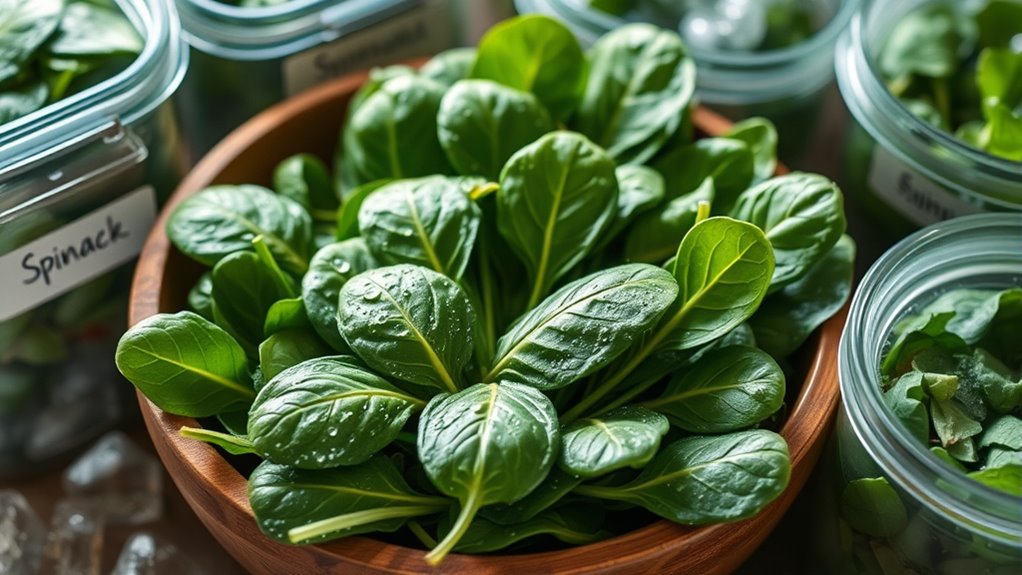To store fresh spinach, keep it unwashed to avoid excess moisture. Use an airtight container or a breathable bag with ventilation for airflow. Layer spinach with paper towels to absorb moisture and place it in the crisper drawer of your fridge. Check for spoilage regularly and remove any wilted leaves. For longer storage, you can freeze spinach after washing and drying it well. Discover more tips to keep your spinach fresh for extended periods.
Key Takeaways
- Store unwashed spinach in an airtight or breathable container to maintain freshness and prevent excess moisture.
- Layer spinach leaves with paper towels to absorb moisture and extend shelf life.
- Keep spinach in the crisper drawer of the refrigerator for optimal temperature and humidity control.
- Regularly check for spoilage and remove any wilted leaves to maintain overall freshness.
- For long-term storage, wash, dry, and freeze spinach in portions, removing air from freezer bags.
Understanding Spinach Shelf Life

When you store fresh spinach properly, you can expect it to last between 3 to 7 days. Several factors influence its shelf life, including temperature, humidity, and the freshness at purchase.
Keep spinach dry; excess moisture speeds up spoilage. Gentle handling minimizes exposure to air and moisture, helping to extend its freshness.
Whole leaves typically last longer than chopped or cooked spinach, with whole leaves lasting about 5-7 days. Chopped spinach usually lasts only 1-2 days due to increased surface area.
If you plan to store spinach, remember that consistent cold temperatures and moderate humidity are essential. Regularly check for spoilage signs to ensure you enjoy your spinach at its best.
Choosing the Right Storage Container
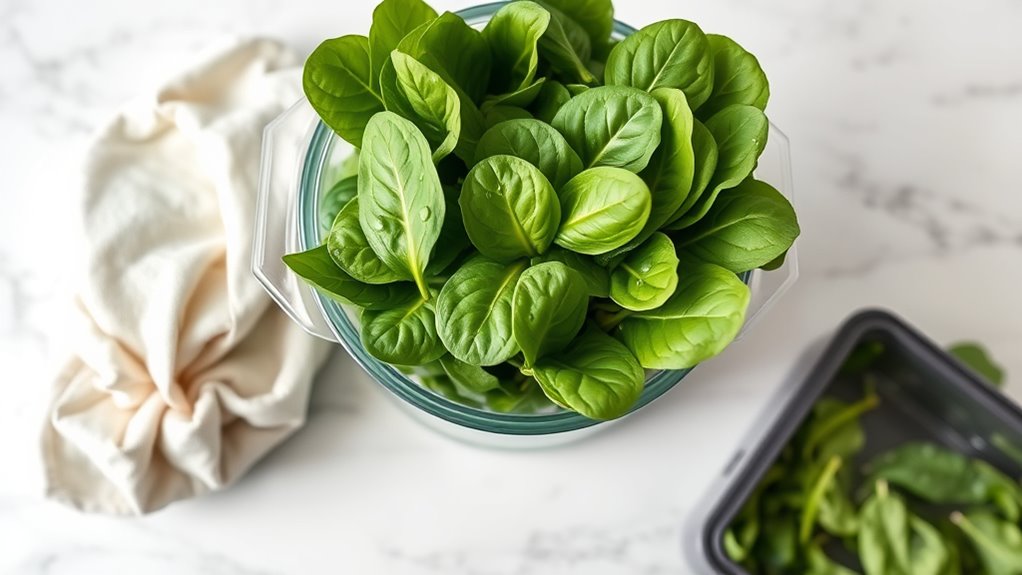
The right storage container can significantly impact how long your fresh spinach stays crisp and flavorful.
Opt for airtight containers to keep moisture out and prevent spoilage. If you prefer airflow, choose breathable containers with ventilation holes that help manage humidity.
Choose airtight containers to block moisture and spoilage, or breathable ones with ventilation holes for optimal humidity management.
Silicone bags are a great eco-friendly option for both fridge and freezer storage. Specialized produce keepers with moisture control can also enhance shelf life.
For versatility, reusable plastic containers work well, especially when paired with paper towels to absorb excess moisture.
Remember, the key features to look for are moisture control, ventilation, and durability.
Tips for Maintaining Freshness
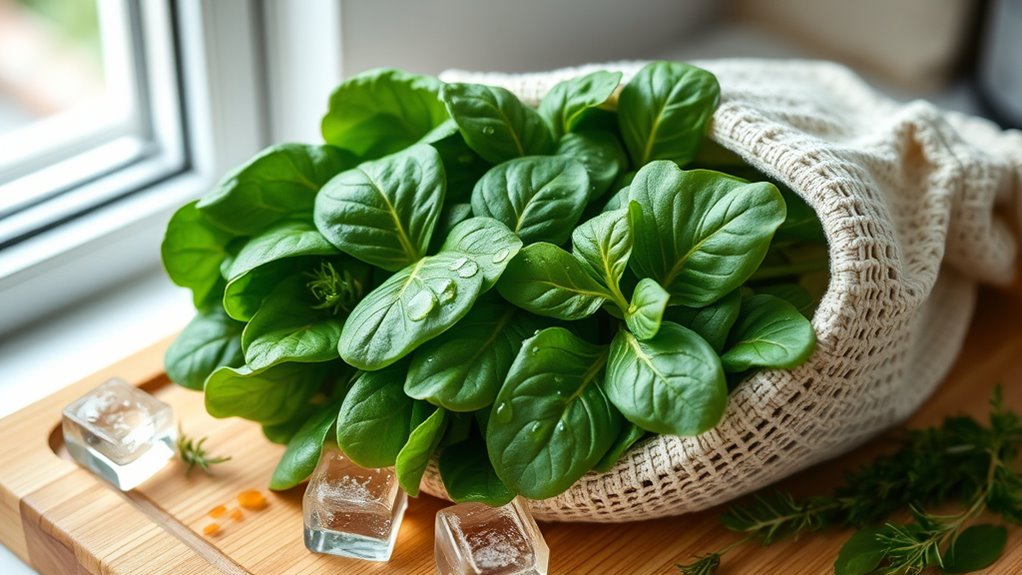
Maintaining the freshness of your spinach hinges on effective moisture control and careful handling. Start by storing unwashed spinach to prevent excess moisture, which speeds up spoilage.
Use breathable containers or bags for airflow, and consider layering spinach with paper towels to absorb moisture. Always pat dry any damp leaves before storage and avoid washing until you're ready to use them.
Store your spinach in the crisper drawer of your refrigerator, where it can enjoy consistent humidity. Keep it away from strong-smelling foods, as they can affect its flavor.
Regularly check for signs of spoilage, like yellowing leaves or a musty smell, and remove any wilted or soggy leaves to maintain overall freshness.
Extending the Shelf Life of Spinach
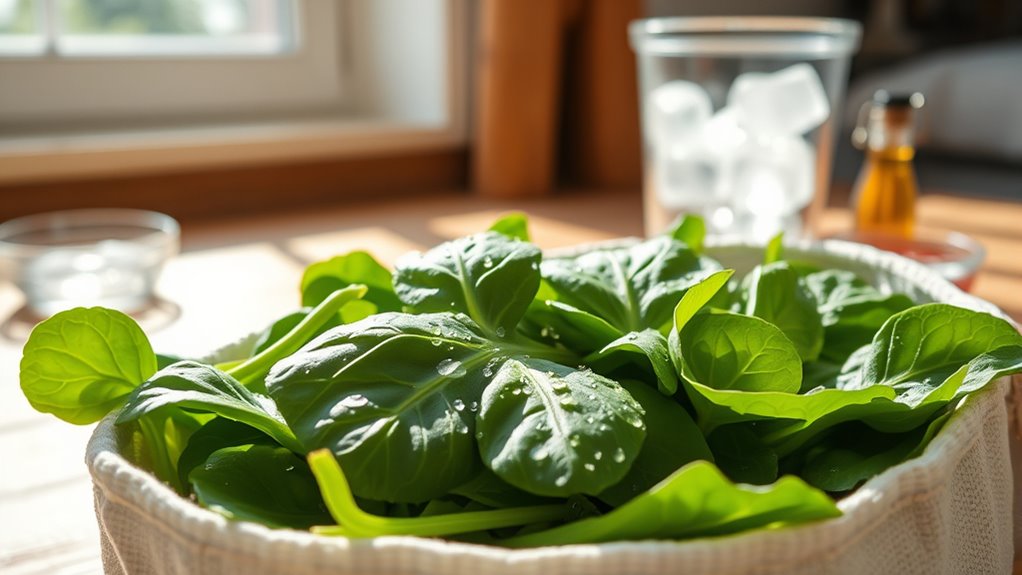
Effective moisture control is key to keeping your spinach fresh, but there are additional strategies you can implement to extend its shelf life even further.
Start by avoiding pre-storage washing; excess moisture can lead to quicker spoilage. Instead, place paper towels in your storage container to absorb moisture, and use breathable containers like perforated bags for better airflow.
Regularly check for moisture and replace paper towels as needed. Make sure to remove any spoiled leaves and sort through your spinach for quality before storage.
Store it in the crisper drawer of your fridge, ensuring it's not overcrowded. For extra moisture control, consider adding bread slices or absorbent materials to your storage setup.
Regularly inspect your spinach to catch any spoilage early.
Proper Freezing Techniques
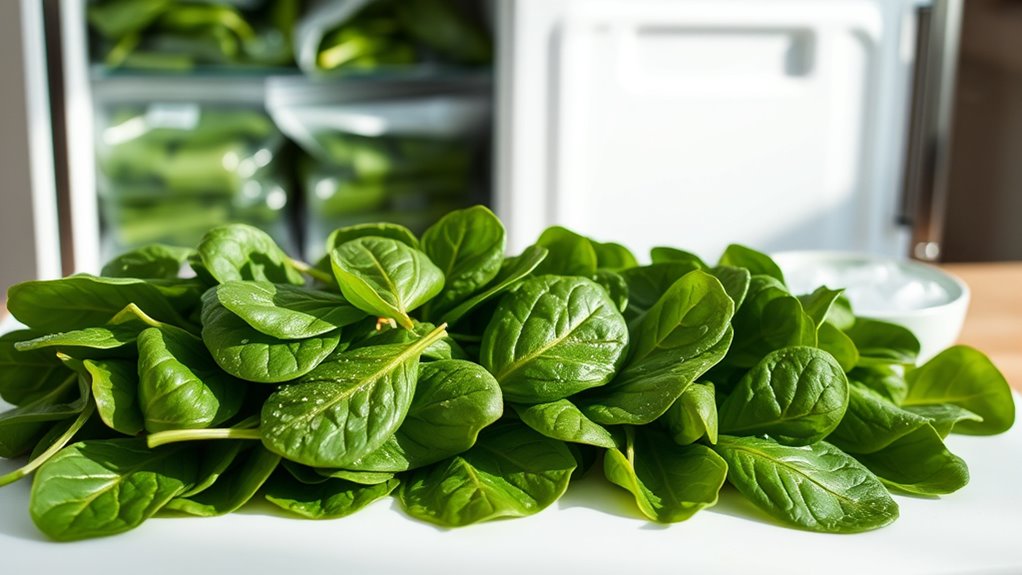
Freezing spinach properly can extend its shelf life while preserving its nutrients and flavor. Start by washing your spinach thoroughly to remove any dirt.
Next, dry it well to prevent freezer burn. You can freeze it without blanching for quick use within six months, or blanch it briefly to enhance flavor and texture for longer storage.
Portion the spinach into freezer bags, removing as much air as possible, and label each bag with the date. Store them in the coldest part of your freezer.
Selecting Fresh Spinach at the Store
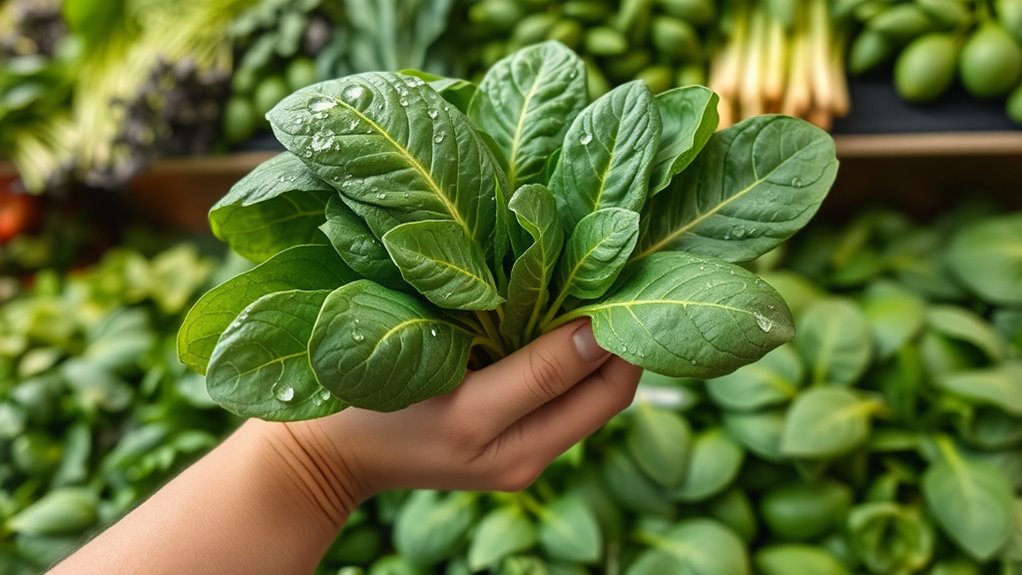
When you're at the store, selecting fresh spinach can make a big difference in your meals. Look for dark green leaves, as they indicate freshness and quality. Avoid bags with excessive moisture, which can lead to quicker spoilage.
Choose firm, non-wilted leaves that have an earthy smell. If you're considering different types, baby spinach is great for salads, while mature leaves work well for cooking. Check the packaging for airflow to keep your spinach fresh.
Always avoid yellow or brown leaves, and remember that smaller leaves are often more nutritious. Finally, handle the spinach gently to prevent bruising, ensuring you bring home the best possible quality for your dishes.
Frequently Asked Questions
Can I Store Spinach With Other Vegetables?
You can store spinach with other vegetables, but it's important to be cautious.
Keep it separate from ethylene-producing veggies like apples and bananas, as they can cause spinach to spoil faster.
Make sure to maintain moisture control, as excess dampness leads to decay.
Ideally, place spinach in a breathable container and monitor it regularly for freshness.
Storing in the crisper drawer helps maintain the humidity spinach needs to stay fresh longer.
How Can I Tell if Spinach Has Gone Bad?
Imagine opening a treasure chest of fresh spinach, only to find tarnished coins instead.
To tell if your spinach has gone bad, look for bright green leaves; yellow or wilted ones signal spoilage.
Feel for sliminess, which means it's time to toss it. Trust your nose—if it smells foul, it's definitely bad.
Inspect for dark spots or mold, and remember, fresh spinach should be mostly dry, not soggy.
Is It Safe to Eat Wilted Spinach?
Yes, it's generally safe to eat wilted spinach as long as it doesn't show signs of spoilage like slime or a strong odor.
You can use wilted spinach in cooked dishes, such as sautés or omelets. If you want to revive it, a quick soak in ice water can help restore its freshness.
Just be sure to discard any leaves that look or smell bad to avoid foodborne illness.
Can I Use a Vacuum Seal for Spinach Storage?
Yes, you can absolutely use a vacuum seal for spinach storage!
Vacuum sealing helps extend its freshness by removing air, which slows spoilage. Just make sure to blanch the spinach briefly before sealing to prevent gas buildup.
Ensure the spinach is completely dry to avoid sogginess. You can store vacuum-sealed spinach in the refrigerator for up to two weeks or freeze it for long-term storage, keeping its nutrients intact.
What's the Best Way to Defrost Frozen Spinach?
To defrost frozen spinach, you've got a few great options.
If you want to take your time, place it in the refrigerator overnight.
Need it fast? Use the microwave's defrost setting or run warm water over it in a strainer.
You can also leave it out at room temperature for a quicker thaw.
Just remember to squeeze out any excess water afterward to avoid soggy dishes.
Enjoy your spinach in soups, stir-fries, or smoothies!
Conclusion
In conclusion, storing fresh spinach properly can make a big difference in its shelf life and flavor. Did you know that spinach can lose up to 90% of its nutrients within just a few days if not stored correctly? By following the tips outlined above, you can enjoy vibrant, nutrient-packed spinach for longer. So, whether you're tossing it in salads or cooking it, take a moment to store your spinach right and keep it fresh!

